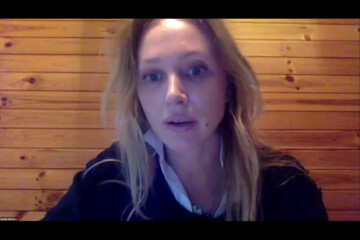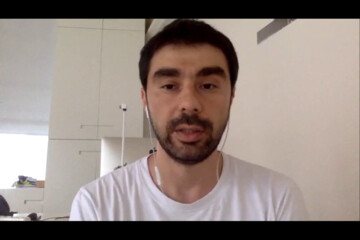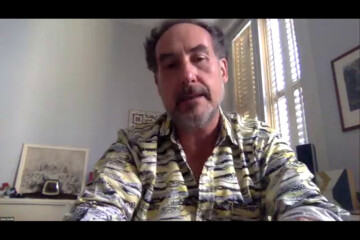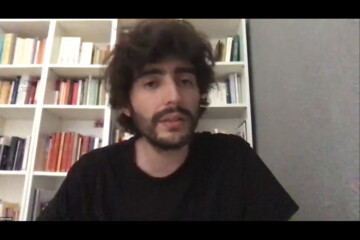What if we could detach repair not only from restoration but also from the very idea of the original – not so that repair comes first but that it comes before? Then, making and repair are inseparable, devoted to one another, suspended between and beside themselves.[1]
— Fred Moten
hammer
is an optimal object
for good sleeping
or hitting nails on the head.[2]
— Adelaide Ivanova, a fragment of poem “The Hammer”
Hammers, like saws, can come in handy as tools of destruction and repair. They double as instruments of possible oppression and self-defence. This is perhaps why the Brazilian poet Adelaide Ivanova advises us to place a hammer underneath our bed for a good night’s sleep. When Kalos, the nephew and apprentice of Deadalus, invented an arsenal of useful tools (including a saw that he made by studying the spines of fish), jealous Deadalus threw the boy off the Acropolis. As Ovid tells us in the Metamorphoses, Athena saved Kalos and turned him into a partridge, an “injured bird” who flies low, close to the ground. Nature, all too often considered as inferior to culture, repaired the latter.
I wish to focus on repair and its two rather perplexing etymological ancestors. Repair, a homonym, was given three lives from two different French roots – repairer and reparer – which due to their similar spellings entered English usage almost simultaneously around the 14th century. Apart from today’s common use of repair, which denotes amending injury or loss, repair or re-pairing may also bring two missing counterparts together. Perhaps, more interestingly, the French verb repairer, designating “to return to one’s home or shelter”, was commonly attributed to animals that create dens and burrows – spaces suitable for habitation and temporary refuges. Repairer is derived in turn from the Latin verb repatriare and patria meaning “native country”.[3]
At the onset of the COVID-19 pandemic, when most countries shut their airspace to commercial → flights, the British government came under heavy criticism from thousands of British Pakistanis for not including them in the repatriation scheme that was launched by the British Home Office to bring its estranged citizens back home. The lack of national and institutional support was perceived by many as a sign of racist prejudice. As borders solidify and nation states grow stronger, selective → travel restrictions and prohibitions based on citizenship and legal status are at the heart of systemic racism that controls the mobility of humans, and which becomes enhanced during various crises. Border control, with its surveillance technologies, is embedded into the ethnonationalist politics of separation. Rather than providing shelter for those who seek asylum and protection, technocratic nation states turn into inaccessible Acropolises. In the analysis of Alexander de Tocqueville’s Democracy in America and the French diplomat’s call for the repatriation of black slaves from America to Africa, the Cameroonian philosopher Achilles Mbembe notes that “repatriation is not exactly the same as reparation”. As he writes “deportation and repatriation are always animated by a genocidal unconscious”[4], by disentanglement, which one could also read in this context as un-re:pairing.
I wonder if we could emancipate repair from its problematic stepsibling patria. What could repair mean for today’s institutions, objects, and most importantly, human beings, beyond compassionate charity, beyond self-congratulatory virtue signalling and beyond the fantasy of self-reparation through the act of repairing the Other? If an apology is an intention and act of speech that precedes repair, and is far too often considered “enough”, how could repair become → rehearsed and performed? Judith Butler reminds us that “even as I have sympathy for another, perhaps for the reparation that another never received for a loss or for a deprivation, it seems that I am, at the same time, making reparation for what I never had, or for how I should have been → cared (→ care) for” therefore “there is always something ‘ungenuine’ in the effort to make another happy, something self-preoccupied”.[5] She concludes by saying that “reparation is fallible and ought to be distinguished from efforts to rewrite, and so deny, the past” and observes that the attempt to repair something (or someone) must always come with the realisation that the damage is there.[6] There should be no room for doubt or an attempt to conceal the traces of the injury.
Perhaps institutions should → learn from those artists who, as creators, know the subtle dialectics between making and unmaking all too well. From those who seek transformation through rapture rather than novelty, growth, and progress. One particular artist who is well aware of the fact that repair and injury are “paired” together forever is Kader Attia, whose sculptures from the series Culture, Another Nature Repaired refer to the concept of repair as resistance, and to the influence that vernacular architecture, military technology and plastic surgery have had on modernism. His sculptures are a result of the artist’s creative cooperation with traditional craftsmen of Bamako, Mali. The inspiration for their creation came from photographs of the so-called les gueules cassées, soldiers mutilated during the First World War. They become totems, akin to deities found in traditional African societies, where broken objects were repaired several times, where injury and repair were closely intertwined – “by repairing an object so roughly you actually leave the injury visible”.[7] There is no best version, repair requires durability and constant improvement. One has to continuously knock and split, which I also understand as necessary for embracing → vulnerability. The Kleinian school of psychoanalysis, black studies and → queer research offer many insights into what reparative work could mean. Eve Kosofsky Sedgwick famously expanded the fantasy of putting the fragmented self into “something like a whole” with a model for the “unmaking of mistakes”[8] one that ought to anticipate the injury which may occur in the future, because repair is not a debt that once paid off, frees one from responsibility to lead an ethical life. Reparation should be understood not only as compensation for an injury, in financial and other forms, but is also something that needs to be constantly anticipated, rehearsed and practised outside of the law in order to produce sustainable results. To return once again to Butler, “the point is not only to find ways to repair the damage we have done (though that is surely important), or even the damage we believe we have done, but to anticipate and forestall the damage that is yet to come”.[9] And perhaps on the most basic level of care, → solidarity and repair, we should really insist on re-pairing ourselves – by reconnecting and recognising our mutual need for → interdependence.






